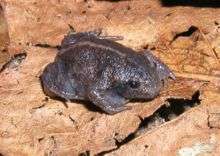Mesobatrachia
The Mesobatrachia are the second-largest of the Anura suborders of amphibians. At the end of 2016, it contained 3 superfamilies (Pelobatoidea, Pelodytoidea and Pipoidea), 6 families, 16 genera, and 244 species. Recognized as a group in 1993, the name (meso- "middle" batrachia "frogs") is contrasted with the primitive Archaeobatrachia and the more diverse and advanced Neobatrachia.
| Mesobatrachia | |
|---|---|
 | |
| Rhinophrynus dorsalis | |
| Scientific classification | |
| Kingdom: | Animalia |
| Phylum: | Chordata |
| Class: | Amphibia |
| Order: | Anura |
| Suborder: | Mesobatrachia |
| Families | |
The Mesobatrachia comprise five fossorial families, including the spadefoot toads of Europe, North America, and East Asia, the parsley frogs, and the Mexican burrowing toad, as well as one obligatorily aquatic family, the Pipidae of Africa and South America.
The Mesobatrachia are a relatively new group, only having been identified as such in 1993.
References
- Gissi, Carmela; Diego San Mauro; Graziano Pesole; Rafael Zardoya (February 2006). "Mitochondrial phylogeny of Anura (Amphibia): A case study of congruent phylogenetic reconstruction using amino acid and nucleotide characters". Gene. 366 (2): 228–237. doi:10.1016/j.gene.2005.07.034. PMID 16307849.
- San Mauro, Diego; Miguel Vences; Marina Alcobendas; Rafael Zardoya; Axel Meyer (May 2005). "Initial diversification of living amphibians predated the breakup of Pangaea" (PDF). American Naturalist. 165 (5): 590–599. doi:10.1086/429523. PMID 15795855.
This article is issued from Wikipedia. The text is licensed under Creative Commons - Attribution - Sharealike. Additional terms may apply for the media files.